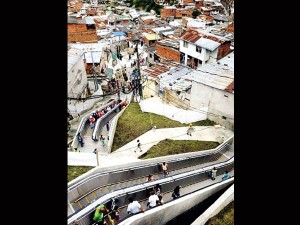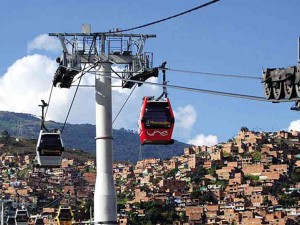
CITIZENS in the favelas of Medellin, Colombia, are transported by escalators to the hilltop which can reach up to a height equivalent to that of a 28-story building. photo: www.huffingtonpost.com
Citigroup and the Marketing Services Group of Wall Street Journal Magazine, along with the Urban Land Institute organized a competition in 2012 to determine which world city would deserve to win the title, “Innovative City of the Year.” The original list of 200 was reduced to 25 and, eventually, narrowed down to three finalists.
The winning entry was distinguished for its progress and potential. Elements such as its modern transit system, environmental policies and its city network of museums, schools, libraries and cultural centers all contributed to its success.
The winning city, which beat New York and Tel Aviv was Medellin, Colombia, a city dubbed not only as the largest but also as the most aggressive due mainly to the carnage brought about by the notorious drug lord Pablo Escobar.
According to Citi and the WSJ’s marketing department: “Medellin stands out because having lived through very dark and difficult times 20 years ago, we have been undergoing a true metamorphosis, from pain and fear to hope, innovating at every step, both in social programs and urban development.”
Social inclusion
The major sign of its recovery is its social inclusion, which consists of an ambitious series of cable cars or gondolas serving hillside communities. It is part of a public transportation system that includes a recently added $7-million escalator climbing one of the steepest mountainsides. Its purpose is to link up the favelas, or squatter communities, to the center of the city and its job opportunities. This escalator cuts down travel time for the community members from two hours to just a few minutes.

THE MAJOR sign of Medellin’s recovery is its social inclusion which consists of an ambitious series of cable cars or gondolas serving hillside communities. photo: gondola project.com
Evidently, the quality of life in the area has dramatically improved. Residents no longer had to pass through dangerous and unhealthy surroundings. They can now travel through areas that are manned by uniformed attendants as they are transported by covered escalators to the hilltop, which can reach up to a height equivalent of a 28-story building.
Similarly, plazas with businesses have been ingeniously developed along with green spaces and public art pieces. The city government has masterfully planned a community composed of new libraries, parks, schools, clinics and strong public transport links.
Co-responsibility
Medellin’s residents, however poor, now feel respected and valued. This has engendered “co-responsibility” where neighbors develop their own housing, cottage industries and resistance to gangs and crime. With a city population of 2.7 million, Medellin has witnessed greatly reduced levels of crime.
Also, the city practices “participatory budgeting,” where citizens are invited to deliberate on how city finances will be disbursed across various areas. This allows the residents of the isolated slums to air their concerns directly to the city government.
The modern metro rail system has greatly alleviated the pollution and lessened crowding in the city’s main thoroughfares. This was a result of a strong collaboration between the government and private enterprises.
Challenge for Metro Manila
Singapore is soon to complete the rapid transit system or RTS to facilitate daily transport between Singapore and Malaysia. In addition, Singapore’s immediate transport plan is to provide links for its citizens from the mass transit system to the bus system with little interruption by covered green walks.
Singapore is also studying how to make the existing two bus lines that run the 200-plus routes improve their services when their licenses expire in three years. This is the same way that London manages its seven bus operators running different packages of routes. Both governments work hard to provide their citizens with transport infrastructure like depots and interchanges to support a contestability framework for future lines.
We hope and pray our government will soon provide us with the same immediate assistance in Metro Manila, where only 10 percent of the population is served by our mass transport system, almost half of the number of vehicles on the road are private cars, and bus and jeepney operators are as many as the birds in the sky.
For comments or inquiries, e-mail amadodejesus@gmail.com.

